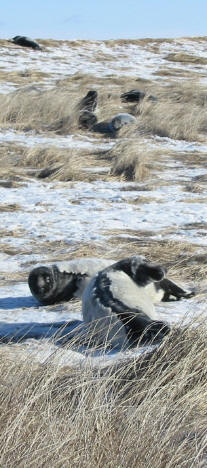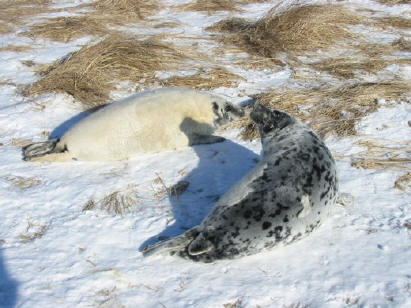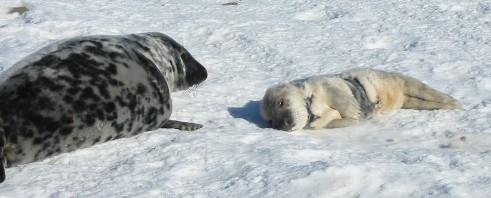|
(home) |
||
|
Nova Scotia Grey Seal Hunt Update, February 10, 2009 Nova Scotia has done another flip-flop on the "Hay Island" grey seal hunt in a wilderness protected area. The hunt was "approved" a few days ago by the Province, and today it was unexpectedly called off by the industry (as also happened last year). The industry is skittish over the "market" potential of the "pelts" while the media have reported that the Province approved "a cull." What is the real story here? If "pelts" from Hay Island are not marketable, are any seal pelts at all marketable, and will there be any Canadian commercial seal hunt at all this year? Or will there just be a "cull" or "predator removal" process? To state the obvious, if seal meat is not truly destined for a commercial food stream (as the public has been told for years that it is), then humane "culling" of seal pups can realistically include the use of "chemical restraint" before slaughter - i.e. knock them out with a tranquilizer dart, as we do with other inconveniently located wild animals in this day and age... Advice from GSCS to the Nova Scotia government: February 6, 2009 (Ron Chisholm's office received this letter by registered mail February 10, 2009) The Honourable Ron Chisholm, Minister of
Fisheries and Aquaculture The Honourable David Morse, Minister of
Environment Re: Grey Seal Conservation Society (GSCS) advice re: Grey Seal Hunt (1) The hunt is not ecologically justifiable (2) If meat is not marketable, “chemical restraint” is recommended Dear Mr. Chisholm and Mr. Morse, Large marine predators provide valuable ecological services and their numbers are now critically low. For this reason, the Grey Seal Conservation Society (GSCS) strongly disapproves of the grey seal hunt recently opened in Nova Scotia. GSCS reiterates its ecological argument against removing predators sent to the Honourable Mark Parent one year ago. As Mr. Parent sent no reply, please now review and acknowledge our letter to him (copy enclosed) and please send us the Province’s rationale for approving the Hay Island seal hunt. We recommend there be no seal hunt. Our focus is on environmental education and marine conservation, but we sometimes offer practical advice to the fishing industry. The GSCS supports ecologically responsible seafood production and believes untapped potential in this area still exists in Nova Scotia. We note, however, that dead grey seals appear to have no real commercial value beyond the sale of the pelts, and that this has practical implications for the industry. The industry’s “Grey Seal Research and Development Society” was abandoned following GSCS’s 2006 report on seal diseases. A recent anecdotal report from Cape Breton raises a concern that infectious agents in grey seal meat may have already caused a costly disease outbreak in farmed mink there, similar to what happened in Ontario when east coast seal meat was fed to mink. In a hunt where seal carcasses are not destined for human or animal consumption, “chemical restraint” can be used during the slaughter process. This is because drug residues that would render seal meat unwholesome for consumption will not affect the marketability of the pelts alone. If seal pups received a quick “tranquilizer dart” and “fell asleep” before slaughter, this would be less stressful to the seals and less distressing to the public than methods currently in use. Has the industry considered this cheap and efficient option? The Province’s animal control officers should have the technical information required for this. If not, through its directors the GSCS has some professional expertise in handling wildlife, which we can make available to the Province and the industry. Practical advice on killing seals from GSCS is offered of course “without prejudice” to our previously stated disapproval of the ecological wisdom of the hunt itself. Sincerely, Debbie MacKenzie, Chair Email: Codmother@bellaliant.net Enclosed: (1) letter to Mark
Parent dated February 17, 2008 Below is the letter the Grey Seal Conservation Society sent by registered mail last year, but that was ignored by the Honourable Mark Parent. Printed copies of this letter were therefore printed and included with the letters sent to The Honourable Ron Chisholm and the Honourable David Morse at this time. When we receive the Province's rationale for approving a seal hunt at Hay Island and the commercial sales statistics on the grey seal hunt to date, we will post that information here. ------------ Hay Island Grey Seal Hunt, 2008 Debbie MacKenzie The Province of Nova Scotia has outdone even Canada's federal Department of Fisheries and Oceans in bungling "conservation", in approving a seal hunt in a protected wilderness area on Hay Island. Nova Scotia knows it has entered a legal “grey area” – fines under the Wilderness Areas Protection Act, the law that has been broken, can reach $500K per day for an individual and up to $1 Million a day for a corporation. And the Crown can be held liable under the law, i.e. for the actions of the Cabinet Minister and the provincial government department that approved the illegal seal hunt. Media reported that Environment Minister Mark Parent had “some misgivings” about the decision, but that he relied on legal advice. The illegal hunt of a few thousand seals on Hay Island this winter is doubtless a prequel to a much larger illegal slaughter of grey seals that the fishermen want to carry out in another protected area, at Sable Island. Below is my letter to Mark Parent, requesting his written reasons for his decision and explaining the value of seals to such wilderness areas. February 17, 2008
The Honourable Mark Parent, Dear Mr. Parent, On behalf of the Grey Seal Conservation Society (GSCS), I am writing to express my extreme disappointment and disapproval of the grey seal hunt at Hay Island, which is not only illegal and ecologically irresponsible, but an embarassment to the province of Nova Scotia. What information did you use as the basis of your decision to approve the hunt? I understand you were asked to approve the seal hunt by Ron Chisholm, provincial Fisheries minister. In a media release, Mr. Chisholm claims he “looked carefully at all the available information” and media reports explained that “fisheries staff gave (Minister Parent) a detailed explanation of the need for the hunt.” Mr. Chisholm explained that the reason his department made the request was to “protect fish species in the Hay Island area.” Media reports further suggest that you relied on legal advice that you could permit the otherwise illegal hunt if it was “for the responsible management, preservation or restoration of indigenous biodiversity of a wilderness area.” The Chronicle Herald reported that the detailed legal analysis considered your possible “responsibility for the fish” that might swim in the water that rises over the protected land at high tide, and that part of the basis of your decision was “whether seals were eating the fish when the tide was in and covering the land protected under the act.” Is this imagined as a threat to the “biodiversity” of the wilderness area? Mr. Parent, with all due respect, that is ludicrous. The seals targeted by the hunt are recently weaned, fasting and moulting, and not yet swimming babies. When these young seals take to the sea, do government lawyers honestly worry that they might return to the intertidal zone to eat fish? The truth is it would do no harm if they did. Why does Nova Scotia allow assessments with legal implications to be completed and used as the basis for decisions without eliciting or considering the opinions of properly recognized experts? Did your review include an assessment of the adequacy or accuracy of “all the available information” that was considered by Mr. Chisholm? Did the material submitted to you by Mr. Chisholm include the expert evidence on this same issue that was recently obtained by the provincial standing committee on resources ? Dr. Boris Worm, associate professor of marine conservation at Dalhousie University, was recently invited by the committee to answer questions on the 'state of the ocean'. Here are a few snippets from the record of the meeting, information that must be "available" to the government:
"MR. WORM: "...seals today are actually not hindering the
recovery of cod but actually are good for the recovery of cod because they
are the only left predators...a lot of what we know is based on hypotheses
and generalizations and a very scant understanding of how marine
ecosystems are working. Now some people would turn this around and say, we
don't know anything so let's just go ahead. I would say we know little, so
let's make use of the little bit we know and be very, very careful about
every new step. That's where I see us failing a little bit because every
new step is not done more carefully than the step before. Rather than considering Dr. Worm’s expert opinion already available to the provincial government, is it possible that the provincial Minister of Fisheries instead relied “in good faith” on opinions from persons without ecological credentials who told him “in good faith” what they believed to be true? And did you as Minister of Environment accept this information plus legal advice given to you “in good faith”? Although possibly sincere, this process does not seem to be a very strenuous truth-seeking exercise. At what point does government “accountability” enter into this? A year ago, the provincial Crown was reported to be prosecuting individuals for offences under the Wilderness Areas Protection Act that arose from illegal seal hunting at Hay Island. Might the Crown next have to defend itself against a prosecution under the same law? Could the matter go to court as a civil case, say, if some well-heeled seal hunt protester decided to finance a lawsuit? (A few years ago, the provincial departments of Justice and Community Services relied on legal advice and ended up landing the Crown in an expensive mess – sorting out all the liability that arose from the mishandled allegations of institutional abuse which was then compounded by violation of the Charter rights of employees and former employees…that time, Nova Scotia taxpayers ended up paying millions of dollars more that they needed to have paid…because of errors made by the Crown, errors quite possibly made in “good faith”…but I digress.) Mr. Parent, the primary objective of the Wilderness Areas Protection Act is to “maintain and restore the integrity of natural processes and biodiversity.” And that is the primary reason you should not have approved the seal hunt. A vital natural process that sustains ocean island ecosystems is the movement of organic matter from the sea to the land. This occurs as various forms of marine life are washed up, crawl out, or are pulled out onto land, to be eaten by land organisms and ultimately integrated into the soil, grass and forests of islands. Seabirds are an example of important players, bringing fish onto the land to feed their young. The food they eat is cycled through pathways that enrich the land. Without this natural process the island soil becomes gradually poorer as rainfall and gravity erode organic reserves. Counteracting the natural washout tendency, some ocean fish seem to virtually offer themselves up for consumption by land animals. Two examples are capelin and grunion, small fish that swim from the open ocean to the edge of the surf by the millions to spawn. Their eggs and spent carcasses feed a host of land animals, representing an important basis of soil building. Fascinating research from the Pacific coast of North America has recently shown how entire forest ecosystems are now impoverished as a result of the loss of salmon runs that always delivered tons of rich food high into the mountains via their annual one-way spawning migrations. Land based consumers from grizzly bears, eagles, foxes, numerous other birds, mammals and insects, to the very trees in the forests themselves, were found to have depended heavily on “marine derived nitrogen” delivered by salmon. Scientists determined that the entire ecosystem is now relatively impoverished by the loss of the salmon runs. On Hay Island, the grey seal whelping congregation delivers an annual pulse of food to the island’s land ecosystem. Grey seals take no food from the land, however eagles, mink and many others feast on the placentas from the births of seal pups, as well as the carcasses of the 10% or more of grey seal pups who will die naturally on land. If a surviving seal pup should later eat a fish in the intertidal zone, does it then become reasonable for the Minister of the Environment and government lawyers to launch an assault on the whole herd? I don’t expect the fishermen have considered that the seals enrich the natural ecosystem on the island, and they honestly do not realize that seal pupping is an important natural process that the Minister is charged with protecting. We have missed key subtleties, which is why the cod stocks are not rebuilding. Rather than “exploding” seal populations, it is more accurate to say we have “imploding” fish populations, as the fish starve. For the bulk of their lives, when not on land, grey seals cycle nutrients in the sea in a pattern that counteracts fish starvation. As Dr. Worm and the law tell us, animals in protected wilderness areas should be left alone. To maintain vibrant life on Hay Island, there should never be a seal hunt there. And on Nova Scotia's unique Sable Island, the largest colony of grey seals in the world contributes to the health of both the surrounding sea life and life on the island itself. 'Marine derived nitrogen' doubtless sustains the famous Sable Island horses. Does the Province next intend to authorize a seal hunt there? Land dwellers owe a great debt to sea animals, perhaps especially to those who have always approached land on their own volition bearing gifts: the salmon, capelin, seabirds, turtles and seals. In their manner of birthing their own kind, these ocean species also benefit life on land. Grey seals are some of these very special animals, virtual ‘goodwill ambassadors’ who occasionally emerge from the sea to enrich the land. However, the direct enrichment of modern humans by seals should come only from our awe in their presence, and our enjoyment of healthy land ecosystems, and never from killing them and selling their pelts. I realize fishermen do not want to hear this, but that does not affect the truth of the matter. I offer a final fact for your consideration, although with no supporting science: The Atlantic grey seal is the basis of the ancient Celtic myth of the ‘Selkies’…a belief that includes a warning to humans against killing grey seals because it brings bad luck. Mr. Parent, I wish you had held public consultations, and that you had listened to your own misgivings before you approved the seal hunt on Hay Island. Are you convinced that due process was carried out? Otherwise, this decision might discredit the integrity of other contentious decisions made by the Department of Environment and Labour, like your recent decision to approve an open pit gold mine at Moose River, Nova Scotia. Please send me a copy of your written decision to approve the seal hunt on Hay Island along with the facts on which your decision was based. Thank you.
Sincerely,
Debbie MacKenzie email: Codmother@bellaliant.net
For more on the ecological
value of seals, see:
"Doctors would be
sued for malpractice if they diagnosed patients the way many scientists
are diagnosing oceans." ...Is the Nova Scotia
solution to let lawyers "diagnose" oceans?
Sign My Guestbook
|
||


